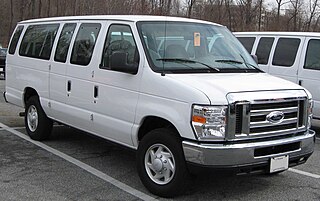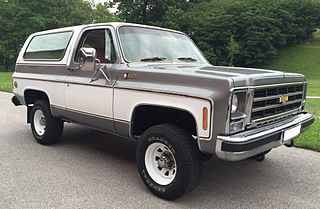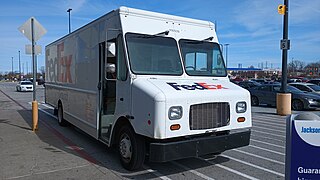
The Buick Skylark is a passenger car formerly produced by Buick. The model was made in six production runs, during 46 years, over which the car's design varied dramatically due to changing technology, tastes, and new standards implemented over the years. It was named for the species of bird called skylark.

The Chevrolet El Camino is a coupé utility vehicle that was produced by Chevrolet between 1959–60 and 1964–1987. Unlike a standard pickup truck, the El Camino was adapted from the standard two-door Chevrolet station wagon platform and integrated the cab and cargo bed into the body.

The Ford E-Series is a range of full-size vans manufactured and marketed by the Ford Motor Company. Introduced for 1961 as the replacement of the Ford F-Series panel van, four generations of the model line have been produced. Marketed for both cargo and passenger transport configurations, the E-Series has been designed with multiple design variations for both retail and commercial sale, including vans, and commercial-grade cutaway van chassis and stripped chassis.

The Chevrolet small-block engine is a series of gasoline-powered V8 automobile engines, produced by the Chevrolet division of General Motors between 1954 and 2003, using the same basic engine block. Referred to as a "small-block" for its size relative to the physically much larger Chevrolet big-block engines, the small block family spanned from 262 cu in (4.3 L) to 400 cu in (6.6 L) in displacement. Engineer Ed Cole is credited with leading the design for this engine. The engine block and cylinder heads were cast at Saginaw Metal Casting Operations in Saginaw, Michigan.
The Chevrolet Stovebolt engine is a straight-six engine made in two versions between 1929 and 1962 by the Chevrolet Division of General Motors. It replaced the company's 171-cubic-inch (2.8 L) inline-four as their sole engine offering from 1929 through 1954, and was the company's base engine starting in 1955 when it added the small block V8 to the lineup. It was completely phased out in North America by 1962, but GM continued to build it in Brazil until 1979. It was replaced by the Chevrolet Turbo-Thrift engine.

The Chevrolet Suburban is a series of SUVs built by Chevrolet since the 1935 model year. The longest-used automobile nameplate in the world, the Chevrolet Suburban is currently in its twelfth generation, introduced for 2021. Beginning life as one of the first metal-bodied station wagons, the Suburban is the progenitor of the modern full-size SUV, combining a wagon-style body with the chassis and powertrain of a pickup truck. Alongside its Advance Design, Task Force, and C/K predecessors, the Chevrolet Silverado currently shares chassis and mechanical commonality with the Suburban and other trucks.

The Chevrolet Express is a series of full-size vans produced by General Motors since 1996. The successor to the Chevrolet G-series van, the Express is produced in passenger and cargo variants. Alongside the standard van body, the line is offered as a cutaway van chassis; the latter vehicle is a chassis cab variant developed for commercial-grade applications, including ambulances, buses, motorhomes, and small trucks.

The Chevrolet Lumina APV is a minivan that was produced by the Chevrolet division of General Motors. The first front-wheel drive minivan sold by Chevrolet, the Lumina APV was sold in a single generation from the 1990 to 1996 model years. Marketed alongside the Pontiac Trans Sport and Oldsmobile Silhouette, the Lumina APV competed against the Dodge Grand Caravan/Plymouth Grand Voyager, the extended-length Ford Aerostar, and the Mazda MPV.

The Chevrolet K5 Blazer is a full-size sport-utility vehicle that was built by General Motors. Being GM's smallest full-size SUV, the K5 Blazer is part of the C/K truck series. Introduced to the Chevrolet line for the 1969 model year, the K5 Blazer was replaced for 1995 by the Chevrolet Tahoe. In 1970, GMC introduced its own model of the truck, called the Jimmy, which was discontinued in 1991 and replaced by the Yukon. The "Jimmy" name was chosen to reflect how GM may sound in a similar manner to how Jeep was thought to be a pronunciation of GP in the competing market. Both were short-wheelbase trucks and available with either rear- or four-wheel drive. Despite all Chevrolet versions from 1969 to 1988 having the "K5" badge, GM never internally referred to the model as the K5 Blazer/K5 Jimmy. Officially, the vehicles have always been referred to as the Blazer/Jimmy, without the K5 prefix. After the release of the S-Series Blazer/Jimmy in 1983, the models were officially renamed "Chevrolet Full-Size Blazer" and "GMC K-Jimmy", though they are often unofficially still addressed as "K5" to avoid confusion.
Bedford Vehicles, usually shortened to just Bedford, was a brand of vehicle manufactured by Vauxhall Motors, then a subsidiary of multinational corporation General Motors. Established in April 1931, Bedford Vehicles was set up to build commercial vehicles. The company was a leading international lorry brand, with substantial export sales of light, medium, and heavy lorries throughout the world.

The Isuzu Faster is a pickup truck that was manufactured and marketed by Isuzu between 1972 and 2002 over three generations. The Faster was succeeded worldwide by Isuzu D-Max, except in Japan and North America.

Canadian Military Pattern (CMP) trucks were mutually coherent ranges of military trucks, made in large numbers, in several classes and numerous versions, by Canada's branches of the U.S. 'Big Three' auto-makers during World War II, compliant to British Army specifications, primarily intended for use in the armies of the British Commonwealth allies, but also serving in other units of the British Empire.

A multi-stop truck is a type of commercial vehicle designed to make multiple deliveries or stops, with easy access to the transported cargo held in the rear. They are usually vans or trucks designed to be used as fleet vehicles by businesses within local areas. They typically use commercial truck chassis with a generally larger, taller body and sometimes also a longer or shorter wheelbase. Though they have traditionally been powered by internal combustion engines, into the 21st century many multi-stop trucks have begun shifting to electric truck platforms.

The Chevrolet Van or Chevy Van is a range of vans that was manufactured by General Motors from the 1964 to 1996 model years. Introduced as the successor for the rear-engine Corvair Corvan/Greenbrier, the model line also replaced the panel van configuration of the Chevrolet Suburban. The vehicle was sold both in passenger van and cargo van configurations as well as a cutaway van chassis that served as the basis for a variety of custom applications.

The Chevrolet Series CA Eagle and Master is an American vehicle manufactured by Chevrolet in 1933 to replace the 1932 Series BA Confederate. The car was called "Eagle" early in the 1933 production year. When it was joined by the cheaper Chevrolet Standard Six later in February, 1933 the Eagle name was changed to "Master" to provide Chevrolet with a two-car range, and for the first time in ten years they manufactured two models on different wheelbases. Starting in 1926, GM introduced the short lived General Motors companion make program where Oakland, Oldsmobile, Buick and Cadillac had "companion" models added to each division. The only division that didn't get a "junior" brand was Chevrolet; instead, the lower-priced Standard series was introduced.

In 1939, Dodge presented a completely redesigned line of trucks. Formally the T series for 1939, V series for 1940, and the W series from 1941 through 1947, the trucks became mostly known as the Dodge Job-Rated trucks.

The first generation of the C/K series is a range of trucks that was manufactured by General Motors from the 1960 to 1966 model years. Marketed by both the Chevrolet and GMC divisions, the C/K trucks replaced the previous Task Force generation of trucks. The first General Motors pickup trucks developed on a dedicated truck platform, the C/K series included pickup trucks, chassis-cab trucks, and medium/heavy commercial trucks.

The second generation of the C/K series is a range of trucks that was manufactured by General Motors. Marketed by both the Chevrolet and GMC divisions from the 1967 to 1972 model years, this generation was given the "Action Line" moniker by General Motors. As with its predecessor, the second generation C/K included full-size pickup trucks, chassis cab trucks, and medium-duty commercial trucks.

The fourth generation of the C/K series is a range of trucks that was manufactured by General Motors. Marketed by the Chevrolet and GMC brands from the 1988 to the 2002 model years, this is the final generation of the C/K model line. In a branding change, GMC adopted the GMC Sierra nameplate for all its full-size pickup trucks, leaving the C/K nomenclature exclusive to Chevrolet.

The Chevrolet Turbo-Thrift engine is a straight-six produced from 1962 to 2001 by the Chevrolet division of General Motors. The entire series of engines was commonly called Turbo-Thrift, although the name was first used on the 230 cubic inch version that debuted in 1963. The new engine featured seven main bearings in lieu of the four bearing design of its predecessor, the "Stovebolt" engine, and was considerably smaller and approximately 100 lbs lighter.



















